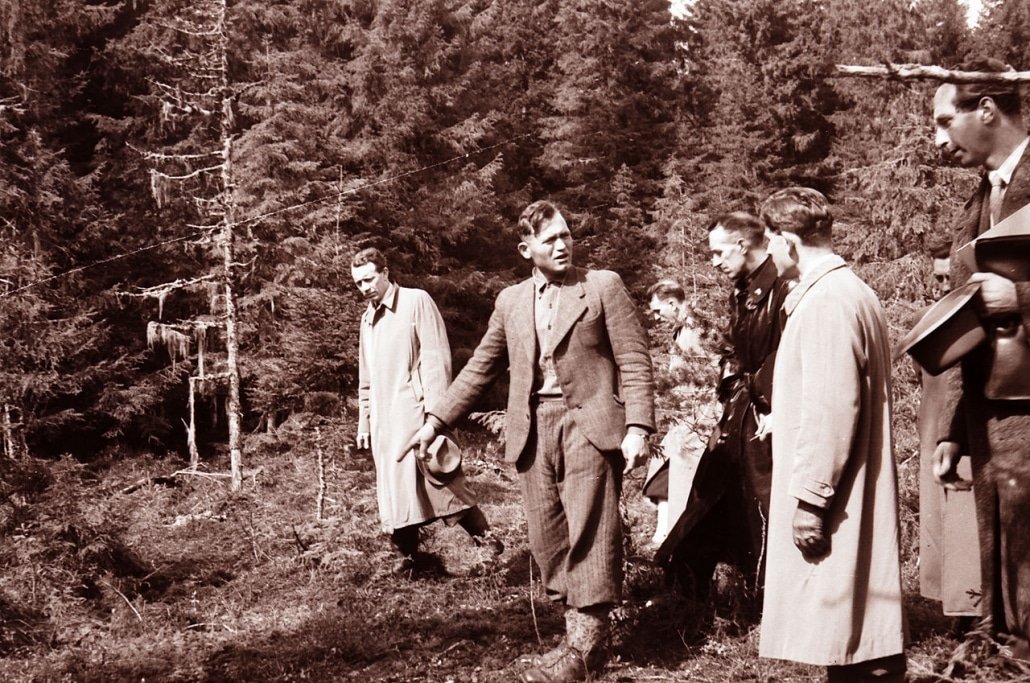Survivor Ljuban Vukovic showing one of the graves in the Falstad Forest in May 1945. Photo: Oskar A. Johansen.
Yugoslav prisoners in Norway
According to Norwegian sources, there were 4268 Yugoslav prisoners in Norway, and about 2400 were killed there. Both during the occupation and after the liberation these camps were called “Camps for Serbs” (serberleirer) as it was well known that the majority of the Yugoslav prisoners were Serbs, mostly from the territories of the Croatian fascist state (NDH – Independent State of Croatia – today territories of Croatia, Bosnia and Herzegovina and Srem in Serbia), but also from other parts of Yugoslavia.
For Yugoslav prisoners the most notorious was the camp in Beisfjord where about 900 Yugoslav prisoners were sent in June 1942. Beisfjord was known for its cruelty and harsh conditions, where, among other crimes, 288 Yugoslav prisoners were shot dead on 18 July 1942. According to the Narvik War Museum, this was the largest massacre on Norwegian soil.
According to Norwegian sources, there were 4268 Yugoslav prisoners in Norway. About 2400 were killed there.
Memorial in the Falstad Forest, Photo: Ole Martin Wold
German camps in Norway for Yugoslav prisoners were called “Camps for Serbs” (serberleirer) as it was well known that the majority of the prisoners were Serbs, mostly from the territories of NDH – the Croatian fascist state, but also from other parts of Yugoslavia.
One of the camps was in Falstad, too. For the Yugoslav prisoners, Falstad became a death camp. Many of the prisoners only spent a short time in prison before their execution. In the period 1942–43, more than 200 were executed and buried in mass graves in the Falstad Forest (the exact number of victims is not known).
Today the Falstad Forest is a national memorial site. Several memorials have been erected in the forest to commemorate the prisoners who were executed, but it is believed that there are still unknown and unregistered graves in the forest. The Falstad Centre Foundation was established in August 2000 as a national centre for the education and documentation of the history of imprisonment in the Second World War, humanitarian international law and human rights. More info: www.falstadsenteret.no
The prison camps in Norway were directly connected to other concentration camps in occupied Europe and Germany. For instance, many Norwegians were detainees at Falstad before being deported to camps such as Sachsenhausen, Ravensbrück and Auschwitz-Birkenau.
Also, many prisoners of the Anhaltelager Semlin – German detention camp at Sajmište near Belgrade – were sent to camps in Norway.
Memorial in the Falstad Forest, Photo: Ole Martin Wold
The Falstad Centre Foundation was established in August 2000 as a national centre for the education and documentation of the history of imprisonment in the Second World War, humanitarian international law and human rights.
German detention camp at Sajmište near Belgrade – Anhaltelager Semlin
After the extermination of the remaining Jews in the territory of Serbia under German occupation by the end of May 1942, Judenlager Semlin – the Jewish camp at Sajmište was transformed into a detention camp, where most of the inmates were Serbs. Although being just outside Belgrade, it was situated in the territory annexed by the Independent State of Croatia, but the camp was under German control. Among the inmates of the camp at Sajmište there were a large number of captured Yugoslav partisans, and partly members of the royalists (chetniks), too, but the largest portion of the inmates consisted of the Serb civilians predominantly from the territories of the NDH – Independent State of Croatia. There were others, too. Between May 1942 and July 1944 in total there were about 32,000 prisoners in the Anhaltelager Semlin. 10,636 were killed in the camp, and the rest were sent to force labor camps in Germany, Norway and other places.
Memorialization and preservation of the authentic site at Sajmište
Today the camp at Sajmište is still not properly memorialized. There is no museum or educational center on the ground of the former camp. Remaining authentic buildings at Sajmište are not properly marked, and many are in very poor condition and endangered.
We hope that this will soon be changed, that all authentic buildings of the former concentration camp at Sajmište in Belgrade will be properly preserved. For that reason we support current efforts by the Serbian Government and other stakeholders, both in Serbia and internationally, on creating predispositions for development of a new Memorial Center “Staro Sajmiste” . #SaveSajmiste
Staro Sajmiste in Belgrade, February 2019, Photo: Misko Stanisic
There is a direct link between Sajmište and camps in Norway, as part of one inseparable experience of terror, stretching from the villages around Kozara mountain, over Sajmište in Belgrade, to the forests around Falstad.
Shared histories and shared memories
Despite that Norway and Serbia are quite far away from each other, on opposite sides of Europe, we have interwoven and shared historical experiences. This is very important not only for education and remembrance in Serbia and in Norway, but for the European memorialization of the crimes committed by the Nazis and their collaborators, as part of one shared European historical experience. There is a direct link between Sajmište and camps in Norway, as part of one inseparable experience of terror, stretching from the villages around Kozara mountain, over Sajmište in Belgrade, to the forests around Falstad.
That is why the natural and proper way for preserving and telling personal stories of victims of these camps is to work together with Norwegian and other colleagues on education about our interconnected and shared historical experiences. International Holocaust Remembrance Alliance IHRA, OSCE/ODIHR, EU EACEA and other international organizations and institutions offers various platforms for such cooperation.
More info (links):
1) The Falstad Centre;
2) A list of Yugoslav prisoners buried in Norway;
3) Yugoslav prisoners in Norway – norgeshistorie.no by the Oslo University (in Norwegian);
4) Concentration camp at Sajmište – historical background and more on Ester.rs;






